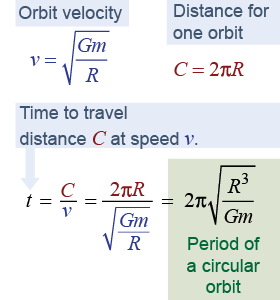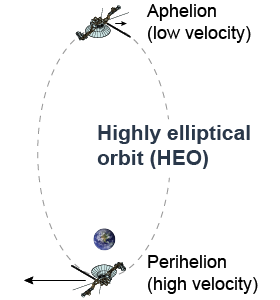|
 The time it takes to complete a full orbit is called the orbital period. Earth’s orbital period is 31,558,149.5 s or 365.256 days. The orbital period of the International Space Station in its low-Earth orbit is 92 min and 50 s, which means the space station orbits the globe in just over an hour and a half. If you know the orbital velocity v and the orbit radius R, then the orbital period for a circular orbit is given by the equation
The time it takes to complete a full orbit is called the orbital period. Earth’s orbital period is 31,558,149.5 s or 365.256 days. The orbital period of the International Space Station in its low-Earth orbit is 92 min and 50 s, which means the space station orbits the globe in just over an hour and a half. If you know the orbital velocity v and the orbit radius R, then the orbital period for a circular orbit is given by the equation 
|
A satellite in geostationary orbit completes one orbit in exactly one day, so its position remains directly over the same place on Earth’s surface. Weather and communications satellites use geostationary orbits because a dish antenna on the ground can receive a signal 24 hours a day by pointing in a fixed direction. If the satellite were not in a geostationary orbit, a dish antenna would have to move around to track the satellite. As of December 31, 2012, there were 404 satellites in geostationary orbit from more than 30 different countries, including 60 from the USA. 
|
A geostationary satellite must have an orbital period of 24 hours (86,400 s) as well as a velocity that satisfies the orbit equation. The combination of these two conditions determines the radius of the geostationary orbit, which is 42,300 km from the center of the Earth. That is an altitude of 35,920 km after subtracting 6,380 km for the radius of Earth itself. 
|
Geostationary satellites orbit above the equator. Above 70° latitude, however, a geostationary satellite appears less than 10° above the horizon. At this low angle reception is difficult. There is no possible orbit in which a satellite hovers directly over a pole, but there is a way for a satellite to spend most of its time over a polar region: using a polar, highly elliptical orbit (or HEO). 
|
 The orbital velocity at aphelion in an HEO is slower than the velocity at perihelion by the ratio of Rp/Ra. By orienting the orbit above the north or south pole, the satellite spends most of its time above the pole where it is moving slowest. A communications satellite in a north polar HEO offers line-of-sight coverage of the northern hemisphere for most of its orbital period. A pair of satellites in north polar HEO and another pair in south polar HEO provide continuous coverage for high-latitude regions of the globe.
The orbital velocity at aphelion in an HEO is slower than the velocity at perihelion by the ratio of Rp/Ra. By orienting the orbit above the north or south pole, the satellite spends most of its time above the pole where it is moving slowest. A communications satellite in a north polar HEO offers line-of-sight coverage of the northern hemisphere for most of its orbital period. A pair of satellites in north polar HEO and another pair in south polar HEO provide continuous coverage for high-latitude regions of the globe. 
|
| |
|

